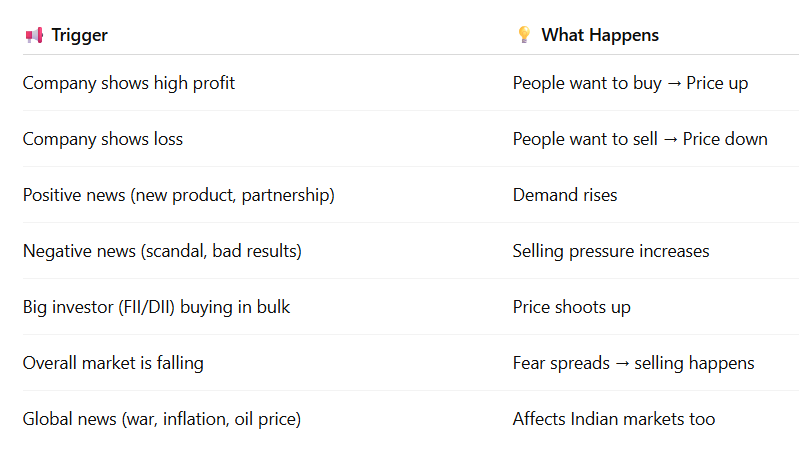S1 E5 : HOW SHARE PRICES MOVE (DEMAND & SUPPLY LOGIC)
🤔 You Might’ve Noticed:
- Tata Motors was ₹720 yesterday, now it’s ₹738
- Zomato was ₹92, now it’s ₹89
- Prices seem to change every minute!
And the big question is:
“Who changes these prices?”
“Is it random? Is someone deciding it?”
Nope. No one sits and controls prices.
It’s all about one simple rule:
Price goes up when more people want to buy.
Price goes down when more people want to sell.
Let’s break it down — in the simplest way possible.
🍅 Real-Life Example: Tomato Market
At your local market:
- If everyone is buying tomatoes, but there aren’t many left → price goes up
- If no one is buying tomatoes, and the market is full → price goes down
That’s basic demand and supply.
🟢 More buyers = demand ↑ = price goes up
🔴 More sellers = supply ↑ = price goes down
The stock market works exactly the same way — but for shares.
💼 Example: Tata Motors Share
Let’s say:
- Many people hear Tata is launching a new electric car 🚗
- Everyone gets excited and wants to buy Tata shares
- Suddenly, 1 lakh people want to buy it
- But only 40,000 people are selling
👉 This causes the price to go up.
Now imagine:
- Bad news comes (e.g., lower profits this quarter)
- People get scared and start selling
- More sellers, fewer buyers
👉 Now price starts going down.
🧁 Simple Analogy: Cupcake Auction
You bake 10 cupcakes and take them to college.
50 people want to buy them.
What happens?
- One person says, “I’ll pay ₹20”
- Another says, “I’ll pay ₹22”
- Another says, “₹25!”
- Price keeps going up
But if no one wants them?
You’ll drop the price to ₹15… then ₹10… maybe ₹5 — just to sell them.
That’s how share prices change — every second.
📊 Why Does Demand/Supply Change?
Here are common reasons share prices move:
-
Company reports high profits
→ Investors feel confident. More people start buying. Result? Price goes up.
-
Company shows a loss
→ Doubts and fear creep in. People begin to sell. Result? Price drops.
-
Positive news like a new product launch or big partnership
→ Hype builds up. More demand for the stock. Price rises.
-
Negative news like a scandal or poor results
→ Panic kicks in. Investors rush to exit. Selling increases, price falls.
-
When big investors (like FIIs or DIIs) buy in bulk
→ Everyone notices. It’s like a signal. Others follow. Price shoots up.
-
If the overall market is falling
→ Even good stocks get sold out of fear. Selling pressure builds.
-
Global events like war, oil price hikes, or inflation
→ Indian markets also react. Prices swing based on global mood.

📉 Example: Zomato Drops After Listing
Zomato IPO price was ₹76
- It shot up to ₹120 in excitement
- Later dropped to ₹50 when profits were low and big investors sold
It wasn’t a mystery — it was just emotions + news + supply/demand.
🧠 Recap in 6 Quick Points
✅ Share prices change every second — not fixed
✅ More buyers = price up 🔼
✅ More sellers = price down 🔽
✅ Demand/supply depends on news, emotions, and results
✅ No single person controls the price — the market does
✅ It’s just like a vegetable or fruit market — but for shares
✨ Final Thought:
The stock market isn’t magic or manipulation.
It’s just millions of people reacting to news, fear, greed, and opportunity — and price adjusts automatically.
The better you understand this, the smarter your decisions become.